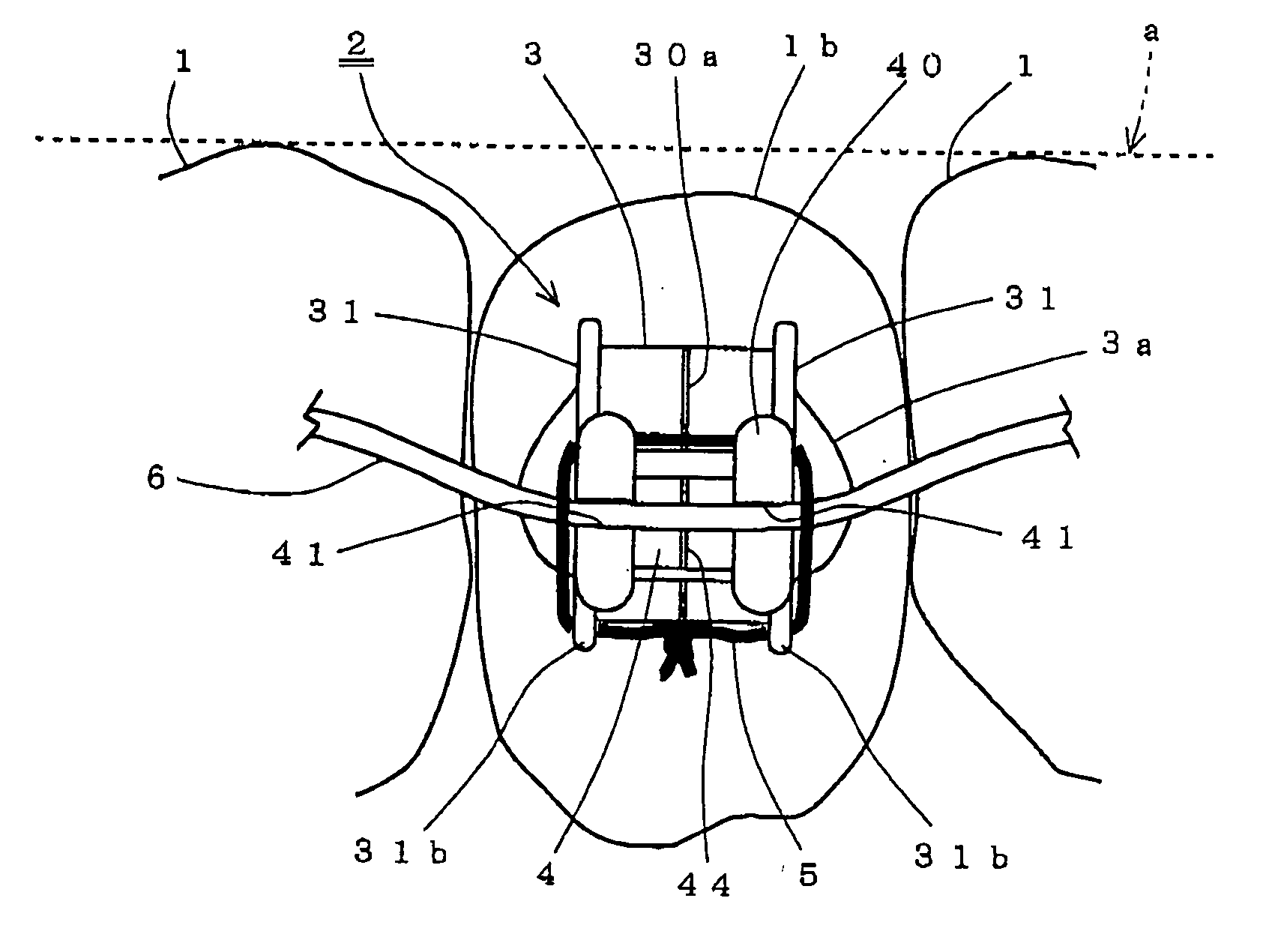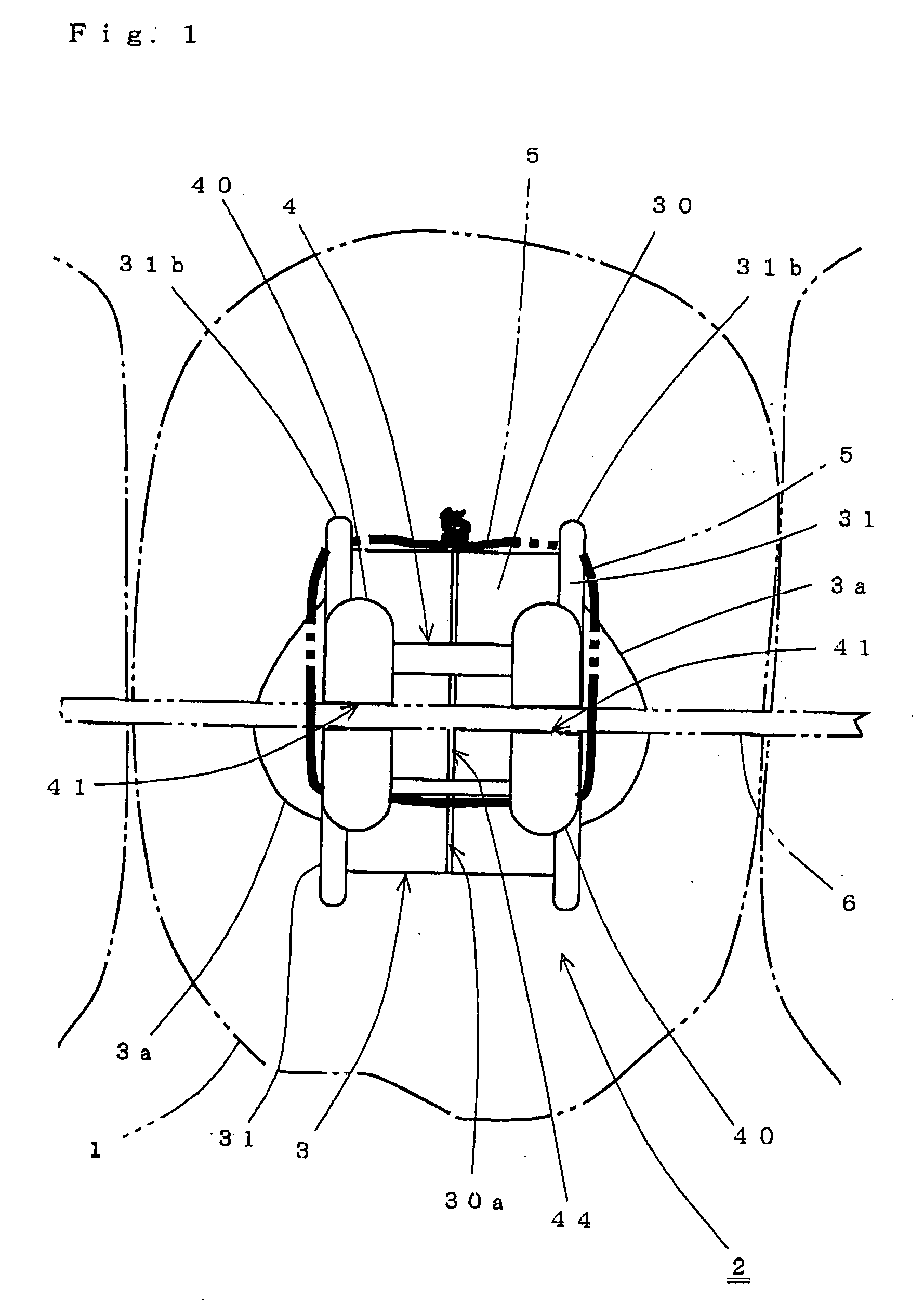Orthodontic bracket
a bracket and orthodontic technology, applied in the field of orthodontic brackets, can solve the problems of occlusion change between the upper and lower teeth, frequent reset of the bracket body and the arch wire with respect to each corresponding tooth, and force patients to carry a heavy burden, so as to relieve patients of burden
- Summary
- Abstract
- Description
- Claims
- Application Information
AI Technical Summary
Benefits of technology
Problems solved by technology
Method used
Image
Examples
first embodiment
[0045] Referring to FIG. 1, reference numeral 2 denotes an orthodontic bracket placed on a side surface (or a front surface) of a tooth 1 subjected to orthodontic treatment. The tooth 1 in FIG. 1 is shown with its lower part as a gingival side (or a root side of the tooth).
[0046] The orthodontic bracket 2 comprises a bonding plate 3a having a bonding surface matching a curve of the side surface of the tooth 1, a base 3 (see FIG. 3) having a bottom surface united with the bonding plate 3a and an upper surface as a sliding surface 30 parallel to a vertical direction of the tooth 1, and taking an approximately rectangular shape in plan with a convex curve formed in accordance with a long axis (or the vertical direction) of the tooth 1, and a bracket body 4 set on the sliding surface 30 of the base 3 in such a way that the bracket body may slide along the long axis of the tooth 1.
[0047] As shown in FIGS. 1 to 7, the base 3 has, on the opposite upper sections of the sliding surface 30,...
second embodiment
[0058] FIGS. 8 to 10 are views showing the orthodontic bracket of a second embodiment according to the present invention including a modification of the bracket body.
[0059] In the second embodiment, there is provided a sliding plate 46 secured to the bottom of the bracket body 4, in which case, the opposite ends of the sliding plate 46 serve to form the guided parts supposed to be let in the corresponding rail 31 of the base 3. The sliding plate 46 has a bottom surface 46a of a concave-curved shape (see FIG. 10) mating the convex-curved shape of the sliding surface 30 (see FIG. 3) of the base 3. The second embodiment has the sliding plate 46 having the bottom surface 46a of the concave-curved shape as described the above, permitting the base 3 to be so placed on the side surface of the tooth 1 as to ensure that more successful matching of a posture of the bracket body 4 to the curve of the side surface of the tooth is obtainable, in cooperation with the base 3 having the sliding su...
third embodiment
[0077]FIGS. 15 and 16 show a third embodiment of the orthodontic bracket involving use of a fixture substituted for the ligature wire. It is to be noted that configurations and / or arrangements of the base 3 and the bracket body 4 in the third embodiment except a fixture-related portion are the same as those in the second embodiment, and hence, their description is omitted. The same is also applied to fourth and fifth embodiments described later.
[0078] The fixture 5a is in the form of a member taking an approximately U-like shape in plan and composed of a basal part 50 supposed to be arranged in parallel to an outside surface of one rail 31 with the fixture attached to the base 3, and a pair of linear legs 51, 51 extending from and approximately orthogonal to the opposite ends of the basal part 60 in one direction, the linear legs being adaptable to hold the bracket body 4 set on the sliding surface 30 of the base 3 from the upper and lower sides of the bracket body. On the other ha...
PUM
 Login to View More
Login to View More Abstract
Description
Claims
Application Information
 Login to View More
Login to View More - R&D
- Intellectual Property
- Life Sciences
- Materials
- Tech Scout
- Unparalleled Data Quality
- Higher Quality Content
- 60% Fewer Hallucinations
Browse by: Latest US Patents, China's latest patents, Technical Efficacy Thesaurus, Application Domain, Technology Topic, Popular Technical Reports.
© 2025 PatSnap. All rights reserved.Legal|Privacy policy|Modern Slavery Act Transparency Statement|Sitemap|About US| Contact US: help@patsnap.com



